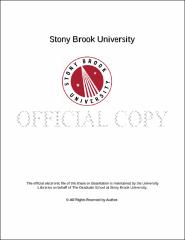| dc.identifier.uri | http://hdl.handle.net/11401/76731 | |
| dc.description.sponsorship | This work is sponsored by the Stony Brook University Graduate School in compliance with the requirements for completion of degree. | en_US |
| dc.format | Monograph | |
| dc.format.medium | Electronic Resource | en_US |
| dc.language.iso | en_US | |
| dc.publisher | The Graduate School, Stony Brook University: Stony Brook, NY. | |
| dc.type | Dissertation | |
| dcterms.abstract | This thesis discusses the approach to hadronic scattering at high energies and the description of the pomeron within holographic QCD. Based on a stringy Schwinger mechanism in curved space, the pomeron emerges through the exchange of closed strings between two dipoles and yields Regge behavior for the elastic scattering amplitude. Our holographic result for the dipole-dipole cross section and the wee-dipole density in the conformal limit are shown to be identical in form to the BFKL pomeron result when the non-critical string transverse dimension is $D_\perp=3$. Thus, we have obtained an evolution for the wee-dipole density as a function of both rapidity, impact parameter and virtuality. The open string picture allows us to define a local Unruh temperature associated to the scattering process, which is large as the impact parameter is large but small compared to the Hagedorn temperature. Associated with the temperature on the boundary, the Unruh temperature allows us to define the free energy of the system. The induced instanton on the string world-sheet carries entropy for a dipole source of N-ality " k" . This stringy entropy is neither coherent nor thermal. We argue that it is released promptly over a time that is solely determined by the impact parameter and the rapidity. It may explain the 3/2 jump in the total charged multiplicities at about 10 participants reported over a wide range of collider energies by PHOBOS. We predict the charged multiplicities in pp, pA and central AA collisions at LHC. The total dipole-dipole cross section is compared to DIS data from HERA and the holographic result for the differential cross section compared to proton-proton and deeply virtual Compton scattering data. With the holographic parameters close to QCD expectations, the holographic results are in reasonable agreement with the data for a variety of observables in the Regge regime. | |
| dcterms.available | 2017-09-20T16:51:04Z | |
| dcterms.contributor | Zahed, Ismail | en_US |
| dcterms.contributor | Dawber, Matthew | en_US |
| dcterms.contributor | Pisarski, Robert | en_US |
| dcterms.contributor | Schneble, Dominik | en_US |
| dcterms.contributor | Teaney, Derek. | en_US |
| dcterms.creator | Stoffers, Alexander | |
| dcterms.dateAccepted | 2017-09-20T16:51:04Z | |
| dcterms.dateSubmitted | 2017-09-20T16:51:04Z | |
| dcterms.description | Department of Physics. | en_US |
| dcterms.extent | 92 pg. | en_US |
| dcterms.format | Application/PDF | en_US |
| dcterms.format | Monograph | |
| dcterms.identifier | http://hdl.handle.net/11401/76731 | |
| dcterms.issued | 2013-12-01 | |
| dcterms.language | en_US | |
| dcterms.provenance | Made available in DSpace on 2017-09-20T16:51:04Z (GMT). No. of bitstreams: 1
Stoffers_grad.sunysb_0771E_11469.pdf: 900191 bytes, checksum: 54a64f6b4e294f8c0564c374220ff21b (MD5)
Previous issue date: 1 | en |
| dcterms.publisher | The Graduate School, Stony Brook University: Stony Brook, NY. | |
| dcterms.subject | Physics | |
| dcterms.title | Holographic Pomeron | |
| dcterms.type | Dissertation | |

